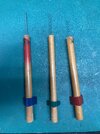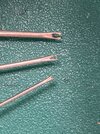Calico Jack
Active Member
- Joined
- Jan 8, 2025
- Messages
- 117
I have used this CA pretty exclusively for photo etch with great results. It's a bit pricey, but offers some flexibility when used with PE that it can take light abuse without parts flying.
https://www.vms-supplies.com/product-page/flexy-5k-ca-xt-thin-contact-adhesive-for-photo-etched
They also have it in a thicker viscosity and also black.
Oh and just a little tip when dealing with photo etch. If you have to make bends or rounding, it's best to anneal the PE beforehand. This will soften the rigidness to allow better bends and retaining them over wanting to spring back to it's original shape and allows easier gluing. HTH
https://www.vms-supplies.com/product-page/flexy-5k-ca-xt-thin-contact-adhesive-for-photo-etched
They also have it in a thicker viscosity and also black.
Oh and just a little tip when dealing with photo etch. If you have to make bends or rounding, it's best to anneal the PE beforehand. This will soften the rigidness to allow better bends and retaining them over wanting to spring back to it's original shape and allows easier gluing. HTH


